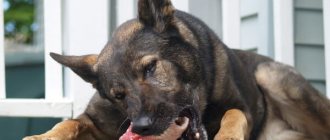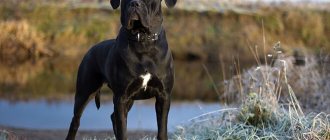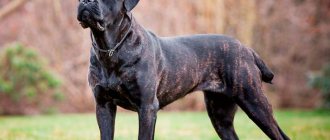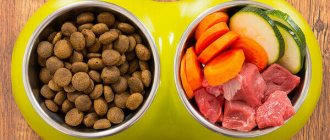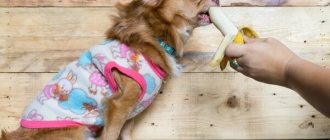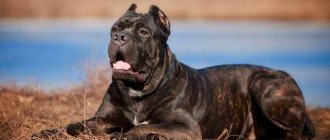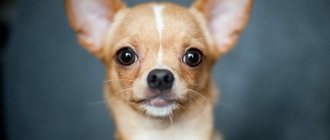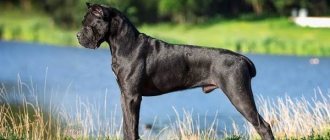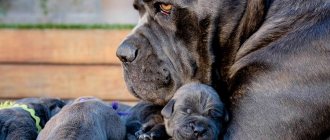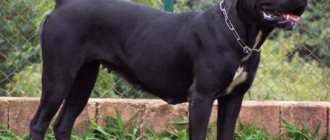The offspring of Tibetan bulldogs - Cane Corso - differ from other dog breeds in their courage, loyalty and, of course, characteristic appearance.
These animals are very patient, courageous, but at the same time very good-natured towards those who are weaker than them.
Therefore, they get along well in families with small children or old people.
Looking at these dogs, it is hard to believe that they all descended from aggressive fighting dogs that took part in bull baiting.
The Cane Corso is a loyal friend, protector and good guard.
Briefly about the breed
This breed is the pride of Italy, it is the 14th breed of dog that was bred in this country . The character of the Cane Corso reflects the courage of a fighter, the dedication of herding dogs, as well as the temperament of Italians.
The Cane Corso strives to protect its owner, protect the home and its own area. It differs from other guard dogs in that it rarely shows aggression towards uninvited guests, only when it feels a real threat to the owner or his property.
To this day, controversy continues regarding the origin of the name of the breed..
There are many versions, but most researchers are inclined to believe that the name of the breed comes from two words: “yard” and “dog”. Literally a yard guard dog.
The Cane Corso is a powerful, robust, extremely strong dog that is both menacing and elegant..
But for a dog to be healthy and active, it needs to be fed properly. This will be discussed below.
4-6 months
At 4 months, the dog has already reached a large size (height at the withers is 47 or 56 cm, depending on gender) and outwardly looks like an adult, but in behavior it is still a puppy who frolics and plays a lot.
Now the baby is not only trying to growl, but is also trying to establish a hierarchy in the family. It is very important to earn the dog’s respect and show that all family members, including children, must be obeyed. Otherwise, the dog will become uncontrollable and will feel like the mistress of the house.
Despite its large size, it is still a “child” who is often afraid even of familiar things. The owner must support the pet and show that the object or sound that frightened it is not dangerous.
Natural or artificial food?
When asking the question of what is better - natural food or artificial food, a reasonable person is unlikely to take one position.
After all, it is clear that both natural and industrial food are quite suitable for keeping a dog, the only question is the quality of the food and the correct feeding of the dog.
It is believed that the Cane Corso is one of the most expensive dogs keep .
The fact is that this breed is quite prone to allergies, as a result of which the owner has to buy expensive hypoallergenic food for his pet for life.
As for the natural diet, it requires constant adjustment depending on the dog’s health and the season..
When feeding a dog, we must not forget that even the highest quality natural products cannot provide it with the required amount of minerals and vitamins.
Expert opinion
Kozhevin Semyon Kirillovich
Expert dog handler.
Most veterinarians recommend feeding your Cane Corso both natural and commercial foods. Of course, industrial food makes the owner’s life much easier, since it is balanced and all the calories in it are counted. It is important to remember the following rule - you cannot mix natural and industrial food, since this can significantly harm the dog’s digestion. If the pet is on artificial food, treats for it should also be selected from industrial ones, but if the dog is fed “natural”, natural favorite foods or pieces of dried meat should be used as treats. You should definitely choose commercial food in strict accordance with the age of the dog. Food for active young dogs contains more vitamins than food for older dogs, and an excess of vitamins and calcium can negatively affect the dog's health.
Origin story
The ancestors of the breed are Molossian dogs. In ancient times, Cane Corsos served as guards, took part in battles and military operations, and tended herds. As time passed, firearms began to be used in battles, and the need for military dogs disappeared. Already at the beginning of World War II, the number of animals decreased significantly.
Today Italians call the Cane Corso their pride. However, despite its cultural and historical significance, the breed was on the verge of extinction even in Italy. It was preserved by a group of enthusiasts who went in the 70s of the last century to look for preserved individuals to where the breed originated - to Locatia, Puria, Sicily.
They managed to preserve the ancient beauty. The breed was officially recognized by the Italian Canine Association in 1994, and in 1996 by the international organization FCI. In 1999, the Association of Italian Cane Corsos was founded. The standard was adjusted and came into force in 2003. It is still used today by the International Cane Corso Federation.
General recommendations
Before planning your Cane Corso's diet, you need to understand that various types of allergic reactions are very common among this breed..
You can determine the allergen in a particular case using the exclusion method and remove this product from the diet; When feeding dry food, it is better to use hypoallergenic food.
Another important issue is the dog’s weight.
Even at a young age, excess fat can have a very negative impact on the condition of the dog’s joints, therefore it is recommended to adhere to the following rules that will help control the dog’s weight at any age:
- You need to feed the Cane Corso strictly following the daily norm; if desired, this norm can be divided into several (2-3) meals, but you cannot feed the dog in excess of the prescribed norm.
- It is imperative to compare the amount of carbohydrate food with the dog’s physical activity. If the load is low, the calorie content of the diet should also be reduced.
- If a dog eats artificial food, it may often ask for more. This is due to the fact that dry food increases in volume only after it enters the stomach. Therefore, immediately after eating, the dog may not feel full. If the owner cannot steadfastly withstand the gaze of pleading eyes, he can give the dog a bone from the tendons, but not an additional portion of food.
- The dog must be weighed regularly.
Basic rules for feeding Cane Corso
From the first days of being in a new home, a Cane Corso puppy should immediately get used to food and order. To do this you need to adhere to the following rules:
- The food bowl should be placed on a vertical counter with a stable stand. The dishes are thus at the level of the pet’s chest or slightly higher, so that he does not have to tilt his head.
- The bowl should be inserted into a metal hoop and secured with a ring or clamp.
- The stand for the bowl should be wide and stable.
- It is recommended to increase the stance as the puppy grows.
- Food should be poured into dishes made of ceramic, aluminum or enamel material.
- A small mat should be placed under the paws to prevent the dog from slipping on the floor while eating.
- The volume of the puppy bowl should hold 0.5 kg of dry food or 500 ml of liquid.
- The dishes must be chosen without defects and potholes to prevent injury to the pet.
- Washing dishes is usually done with warm water and soap or soda, after which they should be thoroughly rinsed under running water.
Attention! The water bowl is installed in the same way on the other side of the stand.
The dog should not bend over while eating; this requires a special stand
Pros and cons of natural nutrition
The benefits of natural nutrition:
- the owner knows exactly what he feeds the dog and chooses the quality of the food himself;
- lack of preservatives and artificial colors;
- if you have allergies, you can replace products;
- The dog's diet contains protein, carbohydrates, fats and fiber.
Minuses:
- it is necessary to spend time preparing food;
- you need to choose the right diet so that the animal receives all the necessary vitamins and microelements;
- it is necessary to introduce vitamin supplements into the diet;
- It is difficult to take a natural dog on a trip, since you will have to look for a hotel where you could prepare food for it.
However, if the owner decides to feed the dog natural food, he should know what products can be used for this:
- boiled or raw meat;
- fish;
- boiled vegetables;
- porridge;
- eggs;
- dairy and fermented milk products.
It is recommended to give the Cane Corso fish oil, salmon oil, and vitamin and mineral complexes as supplements.
Royal Canin Maxi Adult dry for large breed dogs, 15 kg
The animal receives a complete diet thanks to Royal Canin. It is designed for individuals weighing from 26 to 44 kilograms, aged from 15 months to 5 years. Its dry granules contain a unique complex of nutrients that helps the digestive system function optimally. They contain a lot of protein, creating a balance with dietary fiber. Royal has natural taste properties with an aroma that evokes excellent appetite in our smaller four-legged brothers. Category: premium.
- Balanced composition.
- High quality.
- Promotes good digestion.
- Maintaining optimal shape and weight.
- Healthy coat, skin, teeth.
- Convenient, practical packaging.
- The pet likes it.
- Gives activity.
- The crackers smell nice.
- The packaging is made of paper and does not close after opening.
- Unattractive looking bag of granules.
- Possible only from 15 months to 5 years.
Advantages and disadvantages of artificial feed
pros:
- no need to cook;
- no need to calculate portion sizes;
- no additional vitamin supplements are needed;
- variety of feed;
- the ability to take food on the road.
Minuses:
- there is no clear idea about the nature of the production of the food, and it is not a fact that it actually contains natural ingredients, as indicated on the packaging;
- improperly selected food can cause an allergic reaction;
- Cheap feeds use soybeans and low-quality by-products instead of meat;
- feed is produced at high temperatures, which leads to the destruction of vitamins;
- The food may contain preservatives and emulsifiers, which can lead to serious illnesses for the dog.
On the market, all industrial feeds are divided into:
- Economy - both legumes and grains are produced, bone meal, chicken waste, and vegetable oil are added. Often these foods contain dyes and flavoring additives. No vitamins. It is not recommended to feed Cane Corso this food.
- Premium - not much different from the previous class, but it does not contain dyes.
- Super premium - contains natural products (meat, fish, poultry), legumes, supplements for the skeletal system, plant extracts. Example – Royalcanin, Bosch.
- Holistic – only high-quality products, vitamins, probiotics. Example – Akana, Innova.
Belcando Junior Maxi for large and giant breed puppies from 3 to 18 months (15 kg)
Many experts recommend Belcando Junior, made in Germany, for large dogs. Its composition is rich in a high content of poultry meat, in addition to easily digestible rice, which helps good digestion and absorption of useful components. The recipe contains carob fruits, which contain tannins and substances important for life that have an effect on proper digestion. Belongs to the super premium class.
- A complete, balanced complex of nutrients.
- Healthy pet.
- Convenient, economical packaging.
- A wide range of.
- Availability.
- German quality.
- Causes an allergic reaction.
- Not all dogs like it.
- Not sold in all Russian cities.
- Composition with sodium chloride.
- Large granules of strange color.
- Poor combination with vitamins and other products.
- There is a minimum of meat, but a maximum of cereals.
How to choose?
You need to choose only high-quality dry food that is suitable for the age and health of the dog.
An adult and active Cane Corso requires about 800 pellets per day.
IMPORTANT!
You can calculate the amount of feed as follows: per kilogram of animal body weight, about 30 grams of feed are required.
Veterinarians advise paying attention to super premium and holistic food.
First 4 years
The weight of an adult dog already reaches 45 kg for females and 55 kg for males.
As a rule, the first mating is carried out during this period. After it, the males again try to take leadership positions, but this time not within the family circle, but among other dogs. Thanks to their strength, Cane Corsos can cause great harm to other pets with whom they previously played during a walk. Under no circumstances should a dog be allowed to assert itself in this way.
The dog’s character can be adjusted up to three years of age, but the older he gets, the more difficult it is to do this.
What should you add to your diet?
For dogs prone to allergic reactions, fish oil and various vitamin and mineral complexes are recommended.
You should give your dog salmon oil daily, as it contains the Omega acids he needs..
If the owner regularly feeds the dog, during the shedding period the dog will not actively lose hair; moreover, its coat will become shiny and healthy.
Almo Nature Holistic beef 12 kg (for large breeds)
Italian crackers of excellent quality with meat additives do not violate European standards. They have the aroma of real meat, causing an excellent appetite in your beloved pet. They contain protein, but in minimal quantities. The animal receives adequate nutrition by consuming it regularly. Almo Nature belongs to the super premium category.
- Dogs love its taste.
- Hypoallergenic.
- Wide range of tastes.
- Fresh natural ingredients.
- There are no artificial additives, dyes, preservatives, or flavors.
- Sometimes causes hair loss.
- The pet may refuse to eat it.
Feeding a puppy and how much does an adult dog eat?
Up to 4 months, a Cane Corso puppy needs to be fed 4 times a day, up to 7 months – 3 times a day. After 7 months, the dog should be switched to two meals a day.
From 3 weeks of age, cheek feeding should be done every 3 hours . The menu should contain proteins, fats, carbohydrates, vitamins and minerals.
Up to 10 weeks, meat for a puppy needs to be ground, but it is not recommended to feed it with minced meat, since it is poorly digested by the dog’s body.
It is recommended to give your baby rye bread soaked in low-fat broth . From two months old, the dog needs to cook soups with milk, meat or fish broth, as well as liquid porridge from ground cereals.
The norm of liquid food should be 200 grams.
From 6 months you can introduce offal into the diet . Raw beef bones promote healthy and healthy teeth. It is recommended to give your dog a boiled egg, yogurt, cottage cheese, cheese, and butter.
The menu must include cereals and vegetables - carrots, zucchini, beets, cabbage.
The norm of food consumption is set individually . After the baby eats, you need to pay attention to his stomach. If it is swollen, it means the dog has eaten too much.
Next time you need to reduce the portion. If the puppy has eaten food, licked the bowl and, looking into the owner’s eyes, asks for more food, then the portion was not enough, this must be taken into account at the next feeding.
Water must be clean and odorless.
Clinical picture of diarrhea
Diarrhea (diarrhea) is a condition characterized by frequent bowel movements. The excrement has a mushy, thin, watery consistency. Diarrhea in dogs can be acute or chronic, which occurs periodically if the negative factors that caused the diarrhea continue. But as a rule, constant diarrhea indicates profound changes and disturbances in the body.
Important! Chronic diarrhea is most often observed in German shepherds, Great Danes, and Bordeaux dogs. Yorkies, South Russian Shepherds, Pinschers.
As already noted, indigestion is not an independent separate disease, but a symptom of some pathology, illness, or malfunction in the body. Therefore, in addition to diarrhea, owners should be wary of the following symptoms:
- pallor, yellowness, cyanosis (cyanosis) of mucous membranes;
- lethargy, apathy, depression, drowsiness;
- lack of response to external stimuli;
- refusal of food and favorite treats;
- dirty fur near the anus;
- increase in tummy volume;
- mucous, mucopurulent discharge from the nose, eyes;
- sudden increase/decrease in temperature;
- chills, fever;
- cough, difficulty shallow rapid breathing;
- change in heart rate;
- painful defecation, urination;
- refusal of water or vice versa, increased thirst.
The clinical picture, severity, and intensity of symptoms, if they are caused by an infection or disease, depend on the stage, form of the disease, individual characteristics, resistance, and immune potential.
If you notice that the puppy is not eating anything, has become lethargic, apathetic, and other side symptoms are noticeable, do not delay your visit to the veterinarian.
The faster qualified assistance is provided, the greater the chances of saving your beloved pet. Most infectious and bacterial diseases have an aggressive course and occur in an acute, subacute form. Some diseases can be cured at the initial stage of their development. At the same time, uncontrolled use of drugs or self-medication will not produce results and can cause serious consequences.
Nutrition for an adult dog
The diet of an adult dog should include meat. In addition, offal and fermented milk products are needed.
The ideal fish for Cane Corso is blue whiting; it is given once a week, a kilogram per meal..
The menu should also include porridge in meat or vegetable broth with the addition of butter or vegetable oil. Vegetables are needed - pumpkin, carrots, zucchini, cabbage, fresh herbs.
As for treats, pieces of pear, peaches, apples are recommended.
NOTE!
When feeding a dog with industrial food, it is necessary to use high-quality food that is suitable for feeding adult dogs.
It is important to provide your dog with plenty of clean water.
Per kilogram of weight of an adult dog requires 30 grams of dry food and 50 grams of liquid food.
Treatment of infectious diarrhea
For bacterial, infectious diarrhea, veterinarians prescribe Levomycetin, Enterofuril (1 ml for every 2.5 kg), Nifuroxazide, Furazolidone. The dosage, frequency of administration, and duration of treatment are selected by the veterinarian in each specific case.
In addition to treating diarrhea, therapy is aimed at relieving general symptoms and normalizing the condition of the sick animal. Four-fingered patients are prescribed anti-inflammatory, restorative, antibacterial agents, and broad-spectrum antibiotics. To eliminate vomiting - Cerucal, Reglan, other antiemetic drugs. If a dog suffers from debilitating vomiting, the animal is completely limited in food and water. All necessary medications and medications for dehydration are administered intravenously (droppers).
Important! During treatment, owners must strictly follow all recommendations of the treating veterinarian.
The duration of treatment can take from four to seven or more days. Do not skip taking medications, do not exceed the dosage indicated in the instructions for the medication. Medicines in tablets are best crushed into powder, mixed with water and poured into the pet’s mouth using an introducer syringe or a regular one without a needle. You can also add them to food or give them with your favorite treat.
If the puppy is diarrhea due to helminthic infestation, in addition to the main treatment, complex anthelmintics (IN-AP, prazicide, drontal, milbemax) will be prescribed. For puppies, it is best to purchase an anthelmintic in suspension or in the form of sugar cubes. Such medicines have a pleasant taste, so the treatment will proceed without problems.
Pedigree for healthy skin and coat, beef, 13 kg (for large breeds)
PEDIGREE helps reduce the risk of tartar and plaque formation on your pet’s teeth. Provides him with normal digestion. It is preferable to feed your pet dry food in a container separate from wet food, and ensure the availability of fresh drinking water. This is quite healthy, tasty dog food. It is produced taking into account the physiological needs of a large four-legged pet. The food is produced by a Russian company and is designed for the economy category.
- Convenient packaging.
- Pleasant aromatic and taste properties.
- The pet eats with pleasure.
- No artificial flavors.
- High quality crackers.
- Comfortable in using.
- Lots of vitamins.
- The coat takes on a healthy, beautiful appearance.
- Negative reputation.
- Missing useful components.
- Worse than normal nutrition.
- Doesn't do any good.
- Harmful to the health of the animal.
- The pet quickly gets used to this food and does not eat anything else.
- Increases salivation.
Natural products
Many owners feed their pets natural products. To do this, you need to know about the beneficial and prohibited types.
Permitted and prohibited products
You can diversify your dog's diet with the following products:
- chicken and rabbit meat, beef;
- offal;
- boiled sea fish;
- cow and goat milk;
- cottage cheese, kefir, yogurt;
- a small amount of vegetable oil or butter;
- wheat, corn, rice, oatmeal, pearl barley and buckwheat porridge;
- carrots, potatoes, beets, cabbage;
- fruits and berries;
- seaweed.
Purina Pro Plan Optiderma for Healthy Skin and Coat, Salmon with Rice, 14 kg (Large Breeds)
A healthy body and the well-being of an animal are the result of its optimal nutrition. Purina Pro Plan was developed by Russian veterinarians and nutritionists. The composition includes specially selected nutritional components for four-legged pets of different sizes, weights and ages. It suits even special preferences and keeps the animal in excellent condition. Belongs to the premium class.
- Decent composition.
- Wide range for any age, size.
- Nutritious with all the vitamin complex.
- Flavoring additive.
- Doesn't cause much appetite.
- Not available everywhere.
- Creates increased gas formation.
Color
The color of the coat directly depends on the ancestors.
- Black Cane Corsos are closer to Great Danes at the genetic level;
- Gray to Mastino-Neapolitan;
- Cane Corsos are red and brindle to Staffordshire Terriers and Boxers.
The mixing of blood, which was carried out in ancient times, gave unusual results; in addition to color, other features of the appearance and character of the above breeds are noticeable.
